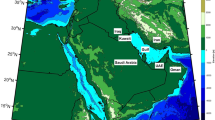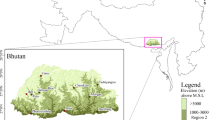Abstract
Maximum and minimum daily temperatures from the second half of the twentieth century are examined using a high resolution dataset of 833 grid cells across the state of Florida. A bivariate extreme value analysis point process approach is used to model characteristics including the frequency, magnitude, duration, and timing of periods or heat waves during which both daily maximum and minimum temperatures exceed their respective 90th percentile thresholds. The temperature dataset is combined with indices of the El Niño-Southern Oscillation (ENSO) and the Atlantic multi-decadal oscillation (AMO) to explore the influence of these oscillations on heat wave characteristics in Florida. In order to investigate the influence of a time varying signal (ENSO and AMO) on heat waves the signals are introduced into non-stationary models as covariates in the location and log-transformed scale parameters. The improvements to the model obtained by introducing covariates are examined using the deviance statistic whereby the difference in negative log-likelihood values between two models is tested for significance using a Chi squared distribution. Significant improvements in the non-stationary models with ENSO and AMO covariates indicate spatially varying impacts in the frequency, magnitude, and duration of heat waves. In particular, the warm phase of the AMO brings heat waves earlier in the summertime while also increasing their magnitude, frequency, and duration.





Similar content being viewed by others
References
Arguez A, O’Brien JJ, Smith SR (2009) Air temperature impacts over Eastern North America and Europe associated with low-frequency North Atlantic SST variability. Int J Climatol 29:1–10
Brown SJ, Caesar J, Ferro CAT (2008) Global changes in extreme daily temperature since 1950. J Geophys Res 113:D05115. doi:10.1029/2006JD008091
Cebrián AC, Abaurrea J (2006) Drought analysis based on a marked cluster Poisson model. J Hydrometeorol 7:713–723
Chang P, Yamagata T, Schopf P (2006) Climate fluctuations of tropical coupled systems—the role of ocean dynamics. J Clim 19:5122–5174
Chavez FP, Ryan J, Lluch-Cota SE, Niquen M (2003) From anchovies to sardines and back: multidecadal change in the Pacific Ocean. Science 299:217–221
Coles S (2001) An introduction to statistical modeling of extreme values. Springer, Berlin
Coles SG, Tawn JA, Smith RL (1994) A seasonal Markov model for extremely low temperatures. Environmetrics 5:221–239
Coumou D, Rahmstorf S (2012) A decade of weather extremes. Nat Clim Change 2(7):491–496
Cramer H, Leadbetter MR (1967) Stationary and related stochastic processes. Wiley, New York
Curriero FC, Heiner KS, Samet JM, Zeger SL, Strug L, Patz JA (2002) Temperature and mortality in 11 cities of the eastern United States. Am J Epidemiol 155:80–87
Davison AC, Smith RL (1990) Models for exceedances over high thresholds. J R Stat Soc B 52:393–442
Douglas AV, Englehart PJ (1981) On a statistical relationship between autumn rainfall in the central equatorial Pacific and subsequent winter precipitation in Florida. Mon Weather Rev 109(11):2377–2382
Enfield DB, Mestas-Nuñez AM, Trimble PJ (2001) The Atlantic multidecadal oscillation and its relation to rainfall and river flows in the continental US. Geophys Res Lett 28(10):2077–2080
Ferro CAT, Segers J (2003) Inference for clusters of extreme values. J R Stat Soc Ser B (Stat Methodol) 65:545–556
Furrer EM, Katz RW, Walter MD, Furrer R (2010) Statistical modeling of hot spells and heat waves. Clim Res 43:191–205
Gershunov A, Barnett PT (1998) ENSO influence on intraseasonal extreme rainfall and temperature frequencies in the contiguous United States: observations and model results. J Clim 11:1575–1586
Gershunov A, Douville H (2008) Extensive summer hot and cold extremes under current and possible future climatic conditions: Europe and North America. In: Diaz H, Murnane R (eds) Climate extremes and society. Cambridge University Press, Cambridge, pp 74–98
Goodrick SL, Hanley DE (2009) Florida wildfire activity and atmospheric teleconnections. Int J Wildland Fire 18(4):476–482
Goto-Maeda Y, Shin DW, O’Brien JJ (2008) Freeze probability of Florida in a regional climate model and climate indices. Geophys Res Lett 35:L11703. doi:10.1029/2008GL033720
Graham N (1994) Decadal-scale climate variability in the tropical and North Pacific during the 1970s and 1980s—observations and model results. Clim Dyn 10:135–162
Grumm RH (2011) The central European and Russian heat event of July–August 2010. Bull Am Meteorol Soc 92:1285–1296
IPCC (2012) In Field CB, Barros V, Stocker TF, Qin D, Dokken DJ, Ebi KL et al. (eds) Managing the risks of extreme events and disasters to advance climate change adaptation, Cambridge University Press, pp 1–19
Kahya E, Dracup JA (1993) US streamflow patterns in relation to the El Niño/Southern Oscillation. Water Resour Res 29(8):2491–2503
Katz RW, Parlange MB, Naveau P (2002) Statistics of ex-tremes in hydrology. Adv Water Resour 25:1287–1304
Keellings D, Waylen P (2012) The stochastic properties of high daily maximum temperatures applying crossing theory to modeling high-temperature event variables. Theor Appl Climatol 108:579–590. doi:10.1007/s00704-011-0553-2
Keellings D, Waylen P (2014) Increased risk of heat waves in Florida: characterizing changes in bivariate heat wave risk using extreme value analysis. Appl Geogr 46:90–97. doi:10.1016/j.apgeog.2013.11.008
Kelly MH, Gore JA (2008) Florida river flow patterns and the Atlantic multidecadal oscillation. River Res Appl 24(5):598–616
Kerr R (2000) A North Atlantic climate pacemaker for the centuries. Science 288:1984–1986
Kundzewicz ZW, Robson AJ (2004) Change detection in hydrological records—a review of the methodology. Hydrol Sci J 49:7–19
Leadbetter MR, Lindgren G, Rootzen H (1983) Extreme and related properties of random sequences and processes. Springer, New York
Levitus S, Antonov JI, Boyer TP, Stephens C (2000) Warming of the world ocean. Science 287:2225–2229
Maurer EP, Wood AW, Adam JC, Lettenmaier DP, Nijssen B (2002) A long-term hydrologically-based data set of land surface fluxes and states for the conterminous United States. J Clim 15:3237–3251
Nitta T, Yamada S (1989) Recent warming of tropical sea-surface temperature and its relationship to the Northern Hemisphere circulation. J Meteorol Soc Jpn 67:375–383
Photiadou C, Jones MR, Keellings D, Dewes CF (2014) Modeling European hot spells using extreme value analysis. Clim Res 58:193–207. doi:10.3354/cr01191
Rice SO (1945) Mathematical analysis of random noise. Bell Syst Tech J 24:24–56
Rodriguez-Iturbe I, Bras R (1985) Random functions and hydrology. Addison-Wesley, Toronto
Sillmann J, Croci-Maspoli M, Kallache M, Katz RW (2011) Extreme cold winter temperatures in Europe under the influence of North Atlantic atmospheric blocking. J Clim 24:5899–5913
Smith CA, Sardeshmukh P (2000) The effect of ENSO on the intraseasonal variance of surface temperature in winter. Int J Climatol 20:1543–1557
Sutton RT, Hodson DLR (2005) Atlantic ocean forcing of North American and European summer climate. Science 309:115–118
Unkaševic ́ M, Tošic ́ I (2008) Changes in extreme daily winter and summer temperatures in Belgrade. Theor Appl Climatol 95:27–38
Waylen PR (1988) Statistical analysis of freezing temperatures in Central and Southern Florida. Int J Climatol 8:607–628
Waylen PR, LeBoutillier DW (1989) Statistical properties of freeze date variables and the length of the growing season. J Clim 2:1314–1328
Waylen PR, Keellings D, Qiu Y (2012) Climate and health in Florida: changes in risks of annual maximum temperatures in the second half of the twentieth century. Appl Geogr 33:73–81
Wilks DS (2005) Statistical methods in the atmospheric sciences: an introduction. Academic Press, Burlington, MA
World Meteorological Organization (2012) Provisional statement on the status of the global climate in 2012. WMO. http://www.wmo.int/pages/mediacentre/press_releases/documents/966_WMOstatement.pdf
Author information
Authors and Affiliations
Corresponding author
Rights and permissions
About this article
Cite this article
Keellings, D., Waylen, P. Investigating teleconnection drivers of bivariate heat waves in Florida using extreme value analysis. Clim Dyn 44, 3383–3391 (2015). https://doi.org/10.1007/s00382-014-2345-8
Received:
Accepted:
Published:
Issue Date:
DOI: https://doi.org/10.1007/s00382-014-2345-8




